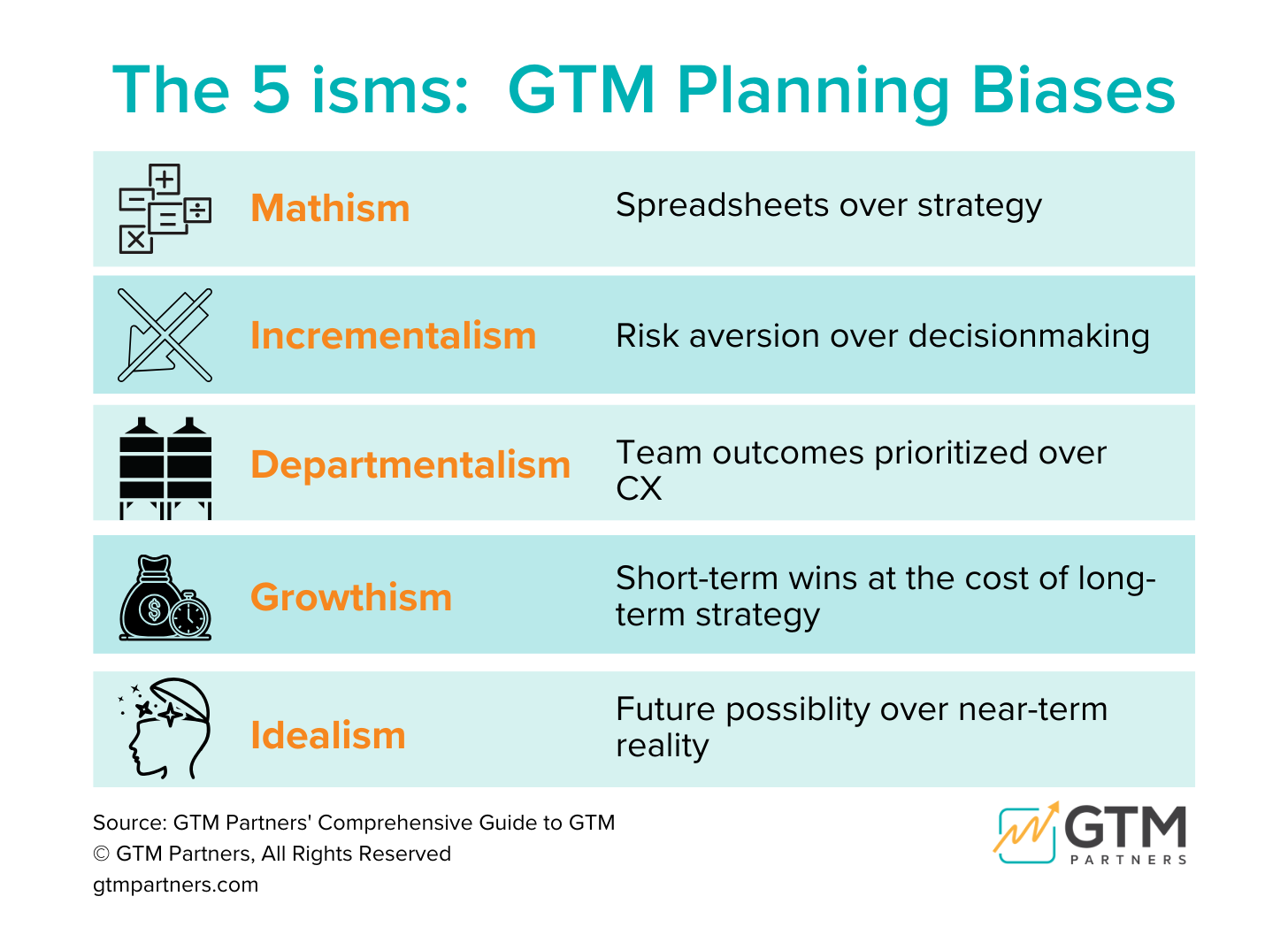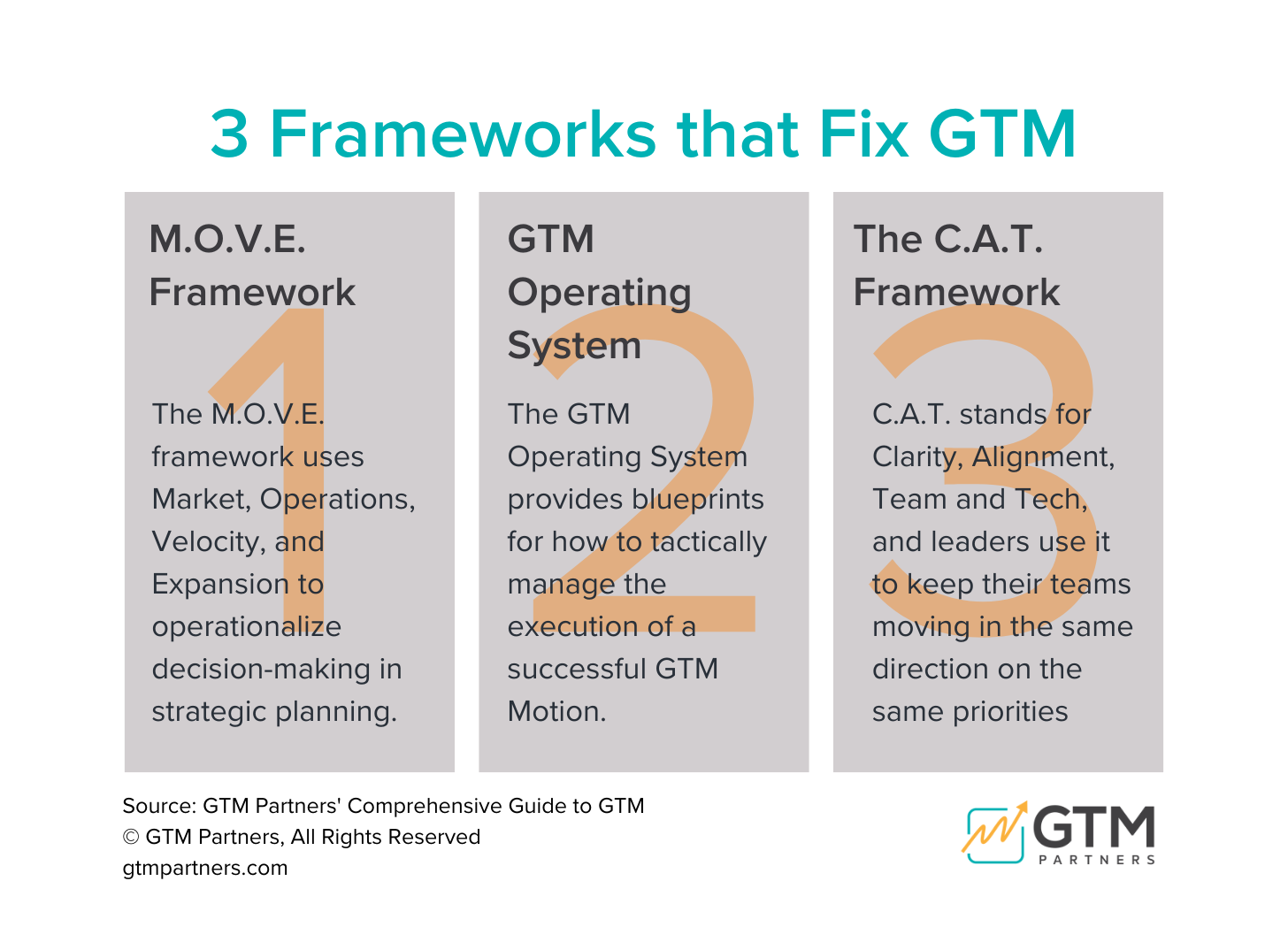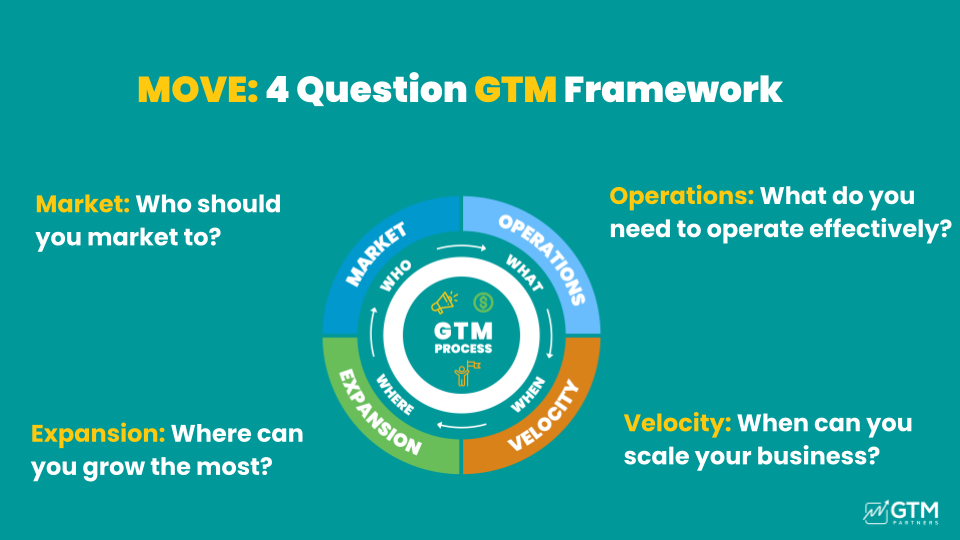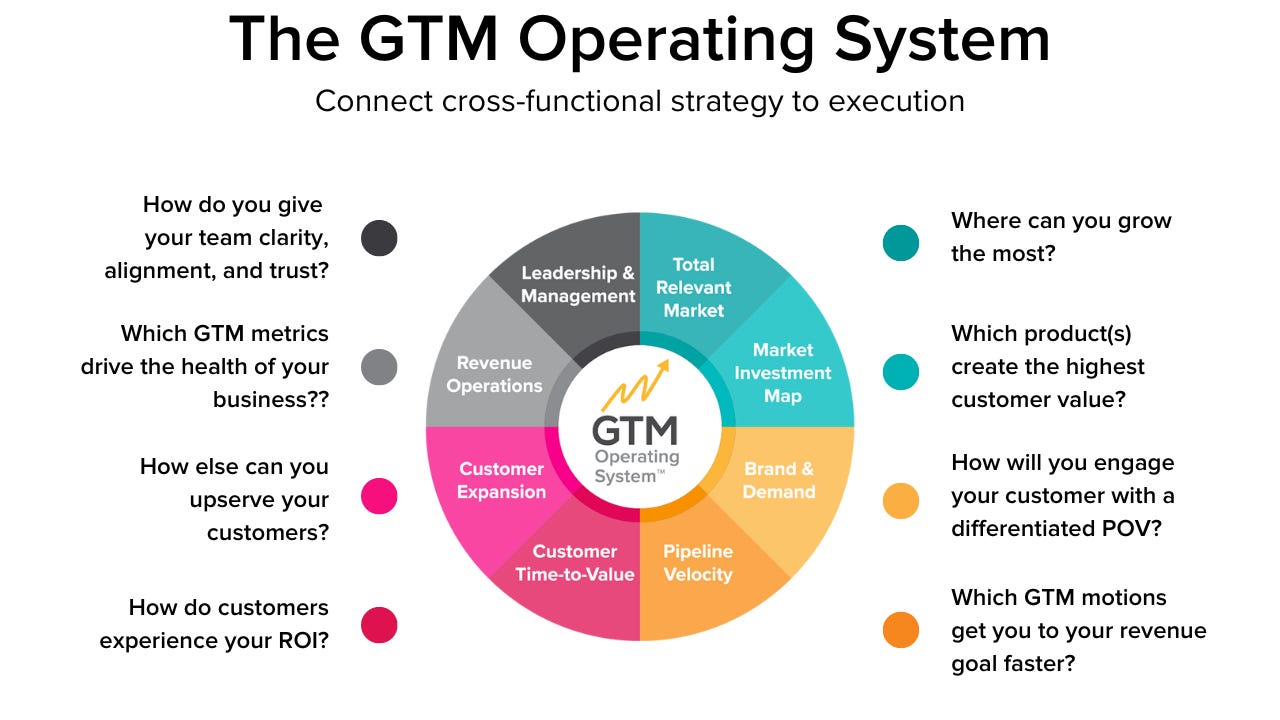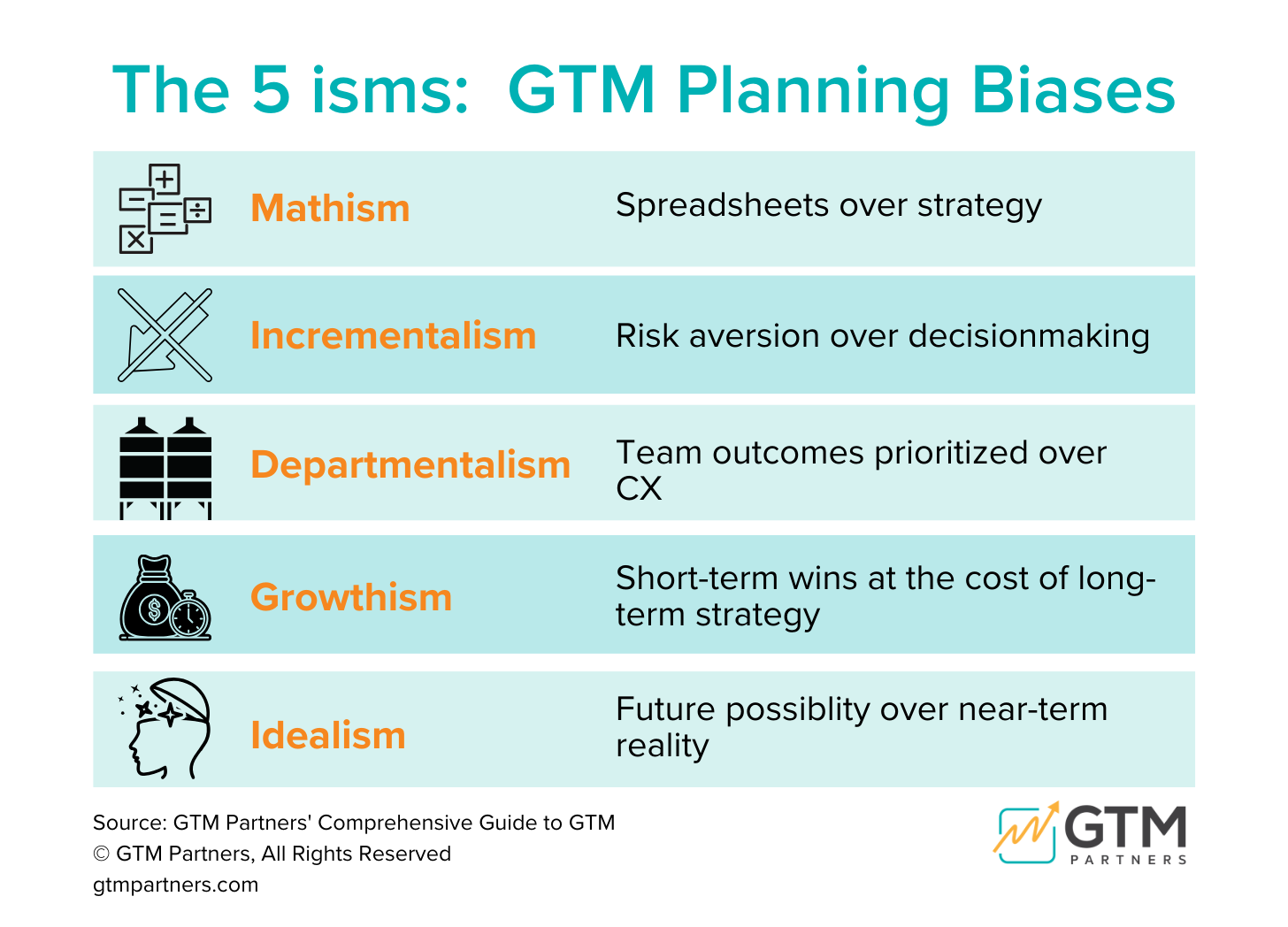Filters
5 Planning Pitfalls GTM Teams Should Avoid
Thanks for being one of more than 73,000 forward-thinking GTM Leaders who subscribe to this weekly research note. We aim to be the go-to for go-to-market, so we appreciate you reading and sharing when you see something you like!
This week’s research note includes:
GTM Research: 5 GTM planning biases
GTM is Better Together: Announcing our keynote speaker for Atlanta
GTM Events: Events you should know about
GTM Research: Watch out for these 5 GTM Planning Pitfalls
A weekly deep-dive into new GTM research and insights
Does this scenario sound familiar?
The CEO and board have set a new revenue target, aiming for a 3x increase in revenue for a specific product or segment next year (gotta get that T2D3 growth curve, y’all).
So you start with some calculations, working backwards from the target.
In order to get to your revenue number, you need X opportunities. In order to get X opportunities, you need Y SQLs. In order to get Y SQLs, you need Z MQLs.
But what if we told you this approach is flawed?
Achieving such an ambitious revenue target demands a comprehensive, integrated GTM (Go-To-Market) strategy.
Unfortunately, you can't simply rely on calculations. Trying to do so is unlikely to help you meet your target without making compromises that could cause problems later on, such as selling to customers who will churn at a high rate or leaning on product features that your core segment is less interested in.
“Mathism” is one of five biases we’ve identified that can hinder the planning process.
Mathism
Mathism is what we just described: relying heavily on spreadsheets and numerical analysis to drive strategy.
Drawback: This approach can lead to overlooking the importance of strategic thinking and the qualitative aspects of planning, potentially resulting in a lack of holistic understanding of market dynamics.
Incrementalism
Incrementalism is characterized by a preference for small, cautious steps in decision-making to avoid risk.
Drawback: This risk-averse mindset can hinder bold, innovative decisions that might be necessary for significant growth and competitive advantage.
Departmentalism
Departmentalism focuses on achieving outcomes at the team or departmental level rather than prioritizing customer experience (CX).
Drawback: This can lead to silos within the organization, where different teams are not aligned with each other or the overall customer-centric strategy, reducing overall effectiveness.
Growthism
Growthism emphasizes short-term gains and wins, often at the expense of long-term strategy.
Drawback: Prioritizing immediate results can undermine sustainable growth, as it may involve cutting corners or making decisions that are not aligned with long-term objectives.
Idealism
Idealism involves focusing on future possibilities without adequately considering the current realities.
Drawback: This can result in plans that are unrealistic and unattainable, leading to frustration and a failure to meet goals due to a disconnect between vision and execution capabilities.
So what is the right approach?
The complexity of modern GTM requires new models and approaches for annual/quarterly strategic planning, goal setting, budgeting, and plan execution.
We need to integrate holistic GTM thinking into the overall strategy and planning process, allowing it to both inform and be informed by these efforts.
At GTM Partners, we utilize various methods and methodologies, but primarily rely on three frameworks for planning and goal setting.
MOVE: the 4 Question GTM Framework
If you want better answers, ask better questions.
These are the 4 questions that can and should define your exploration of your GTM journey:
Who should you MARKET to?
What do you need to OPERATE effectively?
When can you scale your business (VELOCITY)?
Where can you grow the most (EXPANSION)?
You can see already how asking these four questions could help you avoid those five planning biases we just discussed.
Any company that wants to create high-performing GTM revenue teams will benefit from the MOVE framework, because it gives you new ways to get unstuck and keep growing.
The 8-Pillar GTM Operating System
MOVE was just the beginning.
Our work over the last two years has been about expanding on MOVE and building repeatable, predictable frameworks to address these challenges and answer those four central questions.
The GTM Operating System is an 8-pillar framework that we developed to provide organizations with clarity and alignment in their strategic planning and execution process.
The GTM Operating System is made up of many interconnected parts that allow your GTM team to stay aligned on a common goal, both as a GTM team and within specific disciplines such as sales, marketing, and customer success.
It also allows the owner of GTM within your organization to validate your strategy and understand the capacity of the GTM team.
These eight pillars are critical to ensuring that GTM is a company-wide holistic initiative and not just a marketing/ sales initiative.
The GTM Operating System provides blueprints for how to manage GTM execution across the entire company.
Each pillar builds on the next, allowing you to connect the dots between teams with significantly different roles.
We are building our next cohort of GTM O.S. Certifications now. Join the waitlist to be notified when we launch!
CAT: Clarity, Alignment, and Team
Through our experience at GTM Partners and as GTM professionals over the past 20+ years, we’ve identified that many GTM issues stem from misalignment among leadership, teams, and individual functions.
In fact, our research shows that 68% of GTM leaders say that their biggest roadblock to reaching business goals is not market conditions, not competition, but is lack of internal clarity!
This is where CAT comes in.
Clarity
Clarity is more crucial than certainty.
It means ensuring your team understands the business strategy, decisions, and corresponding goals, along with a clear understanding of what these goals mean within the context of their roles.
While you can rarely be certain about future events, you must be clear about your actions, priorities, and timing.
A clear direction enables teams and individuals to make better day-to-day decisions, keeping them aligned with your strategy.
Alignment
Alignment is more important than being “right.”
While clarity is about overarching strategy, alignment focuses on the details and day-to-day decision-making.
Agreements should be made in a way that everyone can follow.
Being aligned allows for execution, learning, iteration, and transformation as you progress, keeping everyone in sync. This approach helps you arrive at the “right” answer faster, or more likely, one of many possible right answers.
The resulting project list, prioritization, and deliverables provide the direction your GTM team needs.
Team
A well-functioning team is better than individual heroism.
Scale, repeatability, and efficient growth are only achievable with a team-oriented approach.
With clarity and alignment, the need for “heroes” to hit goals is eliminated. You can effectively mobilize all resources to maximize output and efficiency.
A strong team also mitigates the risk of losing an A player. The entire team should be able to connect their work to the goal and feel valued.
Whether you conduct your own CAT session or have GTM Partners assist you, it’s a crucial part of the 2024 planning process.
GTM Transformation Offsite
If you’re interested in putting these frameworks into practice and creating a comprehensive GTM strategy for your team in 2025, we’re hosting an exclusive GTM Transformation Offsite this fall in Atlanta.
We’re inviting just 10 companies to join us for a two-day, all inclusive offsite designed to burn down silos and build a strategy with everyone’s input.
Then after the offsite is over, you get three months of group support to address any issues that come up with implementation.
GTM is Better Together: News and Updates
“GTM is Better Together” is a revolutionary new vision that the future of GTM is better together with unified teams, tech, and trust. This is a weekly feature where we will share the latest announcements related to this important initiative.
Excited to announce our keynote speaker for Atlanta! Drumroll please . . .
Tim Elmore!
Dr. Tim Elmore is founder and CEO of Growing Leaders (www.growingleaders.com), an Atlanta‐based non‐profit organization created to develop emerging leaders. His work grew out of 20 years of serving alongside Dr. John C. Maxwell.
He has written over 35 books, including Habitudes: Images That Form Leadership Habits and Attitudes, Eight Paradoxes of Great Leadership, and A New Kind of Diversity: Making the Different Generations on Your Team a Competitive Advantage.
Are you a GTM leader at an enterprise company?
If so, we would love for you to attend one of our four GTM is Better Together summits:
August 28, 2024: Atlanta, GA
September 10, 2024: Boston, MA
October 22, 2024: New York City, NY
November 20, 2024: San Francisco, CA
Everyone says their event is different and unique, but how many GTM events have you been to that had a line item on their budget for drumming?!?
Hope to see you there!
GTM Events
A list of upcoming events of interest to GTM professionals
July 24, VIRTUAL: Capital Efficient Growth with Metropolitan Group
August 28, Atlanta: GTM is Better Together
September 10, Boston: GTM is Better Together
September 18-20, Boston: INBOUND 2024
October 16, Austin: GTM Made Simple Roadshow
October 22, NYC: GTM is Better Together
November 20, San Francisco: GTM is Better Together
Are you a B2B company between $10-100M in revenue who needs help with your GTM strategy and execution? We’d love to chat.
We so appreciate everyone who has read this far. If you have any feedback, we’d love to hear it, or if there are topics you want us to cover, let us know! You can send it to sarah at gtmpartners dot com.
Love,
The GTM Partners Team

